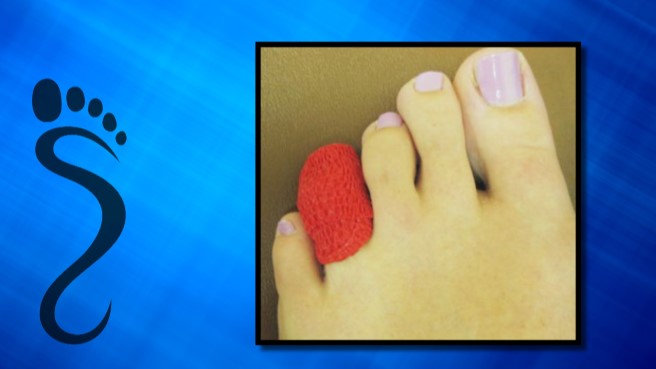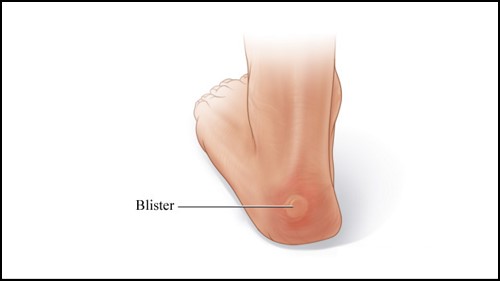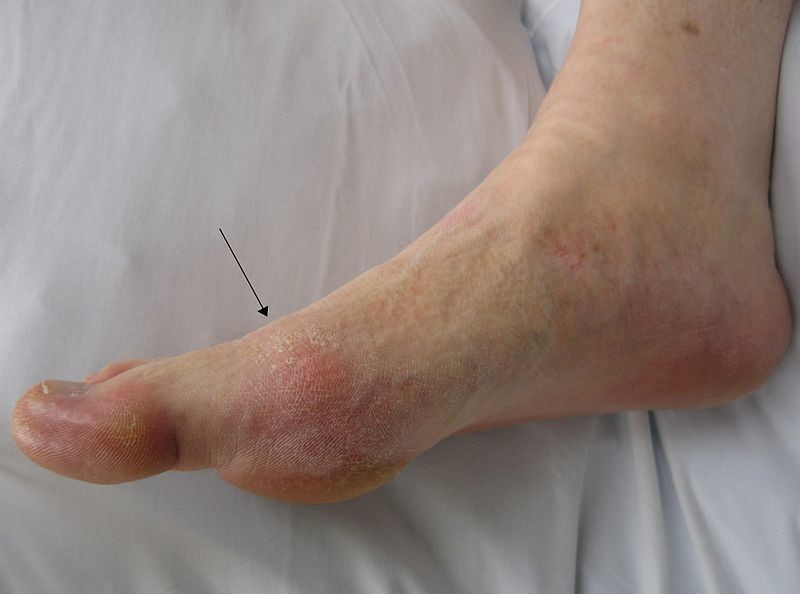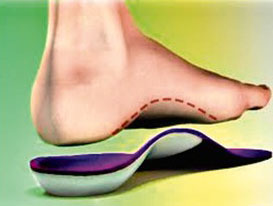December 2014
About Plantar Warts
The term plantar means relating to the foot, which is why plantar warts are only found on the feet. Plantar warts are caused by the human papillomavirus (HPV) getting into open wounds on the feet. These warts are recognizable by a hard bump on the foot. They are mostly found heels or on the balls of the feet. Plantar warts are basically harmless, and may be ignored unless they cause pain or embarrassment.
If you have a plantar wart you may notice some pain when standing, or just some tenderness on the sole of your foot. You will be able to see a fleshy wart, unless it has grown into the foot behind a callus. Since plantar warts are not cancerous and not dangerous, a podiatrist only needs to be seen if there is excess pain, the warts come back often or persist for some time, or if it affects walking. It is extremely important that people suffering from compromised immune systems or diabetes seek out a physician’s care immediately upon finding a plantar wart on their foot.
Doctors can usually easily diagnose plantar warts. The doctor will scrape off a tiny bit of the rough skin to make tiny blood clots visible that make up the inside of these warts. If the doctor is unsure of a diagnosis they may do a biopsy to be certain. Though plantar warts don't often call for treatment, there are many options for combating them if need be. They can be frozen using liquid nitrogen, removed using an electric tool or burned using laser treatment. For a less invasive treatment a topical cream can be used which is available only through a prescription. Over the counter wart medications may help, given enough time and patience.
If you prefer to use home remedies an apple cider vinegar soak is believed to help remove the wart. This treatment takes time. Soak your infected foot in the vinegar for 20 minutes before using a pumice stone to remove any loose skin from the wart. Keep the wart covered for protection in between daily treatments.
The best way to avoid contracting plantar warts is to avoid walking barefoot in public areas. This includes wearing shoes in public showers also. It is also important to avoid direct contact with warts, as they can be contagious. This means not touching your own warts, as well as those on others.
Treatment for Plantar Wart Sufferers
 Plantar warts are typically hard and grainy growths that appear on the heels and balls of the feet. Warts occur when the human papilloma virus (HPV) enters your body through cuts or weak spots on the bottom of the feet. Once plantar warts start to grow, they can take as long as two years to go away if not treated. Luckily there are plenty of treatments to reduce, remove, and prevent the inconvenience. Cryotherapy, also known as freezing therapy, is the most widely used method is removing warts, but it may not always work if the treatment does not reach the entire wart. Over-the-counter salicylic acids and prescription medications are also available aid wart removal process. If a plantar wart is particularly thick, a mixture of cryotherapy and salicylic acid treatments may ultimately do the trick.
Plantar warts are typically hard and grainy growths that appear on the heels and balls of the feet. Warts occur when the human papilloma virus (HPV) enters your body through cuts or weak spots on the bottom of the feet. Once plantar warts start to grow, they can take as long as two years to go away if not treated. Luckily there are plenty of treatments to reduce, remove, and prevent the inconvenience. Cryotherapy, also known as freezing therapy, is the most widely used method is removing warts, but it may not always work if the treatment does not reach the entire wart. Over-the-counter salicylic acids and prescription medications are also available aid wart removal process. If a plantar wart is particularly thick, a mixture of cryotherapy and salicylic acid treatments may ultimately do the trick.
Plantar warts can be painful and can worsen if not treated properly. If you would like to be treated for plantar warts, consult with Dr. Steven Schwartz of Pennsylvania. Dr. Schwartz will attend to all of your foot and ankle needs and provide you with quality treatment.
About Plantar Warts
Plantar warts are found on the feet. These warts are caused by the human papillomavirus (HPV) getting into open wounds on the feet. You can recognize plantar warts by a hard bump on the foot. They are usually found on the heels or balls of the feet. Plantar warts are usually not a sign of anything dangerous but do not ignore them if they do cause pain or embarrassment.
If you do have a plantar wart, you may notice some pain when standing but since these warts are not cancerous or dangerous, a podiatrist only needs to be seen if there is excess pain. Although plantar warts don’t often call for treatment, there are options available. They can be frozen off, removed by an electric tool or burned off using laser treatment.
Home remedies are also available to help with plantar warts. An apple cider vinegar soak can help remove the wart. You can soak your feet in the vinegar for 20 minutes before using a pumice stone to remove any loose skin from the wart.
For more information about Plantar Warts, follow the link below.
If you have any questions, please contact one of our offices located in Chambersburg and Mcconnellsburg, PA. We offer all the latest in diagnostic and treatment technologies to meet your needs.
Read more about Plantar Warts
Blisters on the Feet
If you have ever worn a pair of shoes that were two tight or just rubbed you in the wrong place, then chances are that you have experienced the pain of having a blister formed. To better understand how blisters form, what treatment we should apply for blisters, and how we can avoid having them form, we should learn more about what blisters are.
A blister on the foot is basically a small pocket that is fluid filled. This pocket typically forms on the upper layers of skin, because those layers are so thin. The majority of the time, blisters are filled with clear fluid; however, sometimes the blisters may be filled with blood and even pus if they have become infected due to bacteria entering the blister pocket.
Blisters on the feet are almost always a result of a shoe rubbing the foot constantly which results in what is termed a friction blister. These blisters occur after you have walked for very long periods of time or when you wear a pair of shoes that do not fit your feet properly. Blisters also form more easily if your feet are moist.
If you experience the displeasure of having a blister form on your foot, then proper treatment is an absolute must to alleviate pain and to prevent infection. In general the best treatment for blisters that are full of clear fluid is to just leave them alone. Your body will form new skin under the blister and then when the time is right your body will allow the blister to pop. If you try to lance the blister you may introduce bacteria in it that will lead to an infection. If the blister is painful, then you can use a band-aid over it to provide some cushioning which should relieve pain.
If the blister is filled with blood or pus, then the best treatment is to seek out the attention of a doctor. These blisters may need to be further evaluated and you may be given antibiotics to destroy any infection that you may have.
Preventing blisters on the feet is the best way to prevent any pain or infection that could occur. You can prevent blisters by keeping your feet dry and by making sure that you wear a proper pair of shoes that fit your feet well, without being too tight or too loose. If you do feel a place on your foot where your shoe is rubbing, then applying a band-aid to that spot may prevent a blister from forming until you can change them.
Blistered Feet do not deter Natalie Imbruglia’s Hike across Switzerland
 Natalie Imbruglia revealed extremely swollen and blistered feet after hiking over one hundred miles across Switzerland. As a part of the Strive challenge, the Australian actress and singer embarked on a seven-day journey across Switzerland on August 23rd. The challenge was in support of non-profit organization Virgin Money Giving, which is raising funds for projects dedicated to changing the way young people think. Imbruglia had a physiologist visit and tape up her beaten feet on the sixth day of her journey. The hike spanned from Switzerland’s south-western village of Verbier all the way to Zermatt in the Swiss Alps.
Natalie Imbruglia revealed extremely swollen and blistered feet after hiking over one hundred miles across Switzerland. As a part of the Strive challenge, the Australian actress and singer embarked on a seven-day journey across Switzerland on August 23rd. The challenge was in support of non-profit organization Virgin Money Giving, which is raising funds for projects dedicated to changing the way young people think. Imbruglia had a physiologist visit and tape up her beaten feet on the sixth day of her journey. The hike spanned from Switzerland’s south-western village of Verbier all the way to Zermatt in the Swiss Alps.
Untreated blisters can worsen and make mobility extremely difficult and painful. For quality blister treatment, see Dr. Steven Schwartz of Pennsylvania. Dr. Schwartz will attend to all of your foot and ankle needs and answer any of your related questions.
Blisters on the Feet
When tight or ill-fitting footwear is worn, many times a foot blister may develop. Blisters can even develop by constant rubbing from the shoe, often times leading to pain.
What is a Foot Blister?
A foot blister is a small pocket that is filled with fluid, forming on the upper most layer of the skin. Blisters are filled with clear fluid, and may lead to drainage of blood or pus if the area has become infected.
How do they Form?
Blisters of the feet are almost always the result of shoe rubbing and constant friction of the skin and material. Long periods of walking in shoes, sandals, or boots which don’t fit properly can result in a blister. Those who often have moisture or humidity in the feet, are prone to blister formation easily.
Prevention & Treatment
Proper care is vital to alleviate pain and prevent infection to the affected area of the foot. The best treatment is to leave them alone. New skin will develop under the blister and during the healing stages, your blister will pop.
For more information about Blisters on the Feet, follow the link below.
If you have any questions please feel free to contact one of our offices located in Chambersburg and Mcconnellsburg, PA. We offer the newest diagnostic and treatment technologies for all your foot and ankle needs.
Read more about Blisters on the Feet
What is Gout?
Gout is a form of arthritis that is unusually painful. A slight touch can send shooting pain. The most common area for gout to occur is in the metatarsal phalangeal joint of the big toe. Other areas of the body frequently affected by gout are the knees, elbows, fingers, ankles and wrists.
Gout occurs when there are elevated levels of uric acid in the blood. This condition is called hyperuricemia. Hyperuricemia is a genetically pre-disposed condition about 90% of the time and occurs because the kidneys do not produce the correct amount of uric acid. Children of parents who have had gout will have a 20% chance of developing it themselves. The excess uric acid in the blood forms crystals that deposit in between joints causing friction with movement.
Symptoms of gout caused by this friction include pain, redness, swelling, and inflammation. Fever and fatigue may occur as well, although these symptoms are rare. The pain can be worse during the night when the body’s temperature lowers.
Gout can be diagnosed clinically by a doctor’s observation of the redness, swelling, and pain. More definitive tests can be performed by the doctor as well. Blood tests check for elevated uric acid levels in the blood. The synovial fluid in the joint can also be withdrawn through a needle to be checked for uric acid crystals. Chronic gout can be diagnosed by X-ray.
Treatment given for acute gout diminishes the symptoms. Non-steroid anti-inflammatory drugs such as Colchicine and other corticosteroid drugs will stop the swelling, redness, and inflammation in cases of acute gout. If gout becomes chronic, there are multiple ways to combat it. Lifestyle changes and changes in diet may be necessary, as well as preventative drugs.
Gout can be aggravated by a sedentary lifestyle. Exercise will reduce probability of future cases of gout. Certain foods cause or increase the risk of gout and their consumption should be avoided or kept at a minimum. These foods include red meat, alcohol, sea foods, and drinks sweetened with fructose.
Lifestyle changes and diet that help prevent gout include exercise and certain foods that help decrease the chance of gout recurring. Gout preventative foods include Vitamin C, coffee and some dairy products. New drugs have been discovered that inhibit the body’s production of certain enzymes. These are the enzymes that produce uric acid. Lowering your levels of uric acid will greatly reduce the chances of developing further cases of gout.
Gout Occurs depending on Certain Temperatures
 Students at Boston University School of Medicine conducted research experiment that shows a correlation between high temperatures and the reoccurrence of gout attacks. The head scientist, Tuhina Neogi, MD, PhD, and other faculty members started by gathering data from over 600 patients with suffering from gout using a questionnaire. The ages of the patients ranged from 21 – 88.
Students at Boston University School of Medicine conducted research experiment that shows a correlation between high temperatures and the reoccurrence of gout attacks. The head scientist, Tuhina Neogi, MD, PhD, and other faculty members started by gathering data from over 600 patients with suffering from gout using a questionnaire. The ages of the patients ranged from 21 – 88.
According to the data, it was discovered that temperatures of 70°-79° F were associated with a 43% increase of a potential gout attack occurring. When the temperature reached over 80° F the risk changed to 40%. Following their findings, researchers stated, “Patients with gout may be advised that under conditions of hot and/or dry weather, appropriate measures, such as increased water intake, should be considered to minimize the risk of recurrent gout attacks.”
The severity of gout attacks can vary, but they should always be granted proper medical care. For assistance with a foot condition like gout, consult with Dr. Steven Schwartz. Dr. Schwartz can figure out why you keep getting flare-ups and work with you to treat the root of the problem.
What is gout?
Diseases of the feet can affect the whole body, and symptoms usually arise within the feet. A condition like gout can make a patient’s ability to walk unbearable. The pain caused by this disease is often so agonizing that it requires elevation of the feet and some time off for them to fully recover.
Known in the past as “the disease of kings”, Gout is caused by an excess of uric acid in the body. Some common symptoms include pain, inflammation, and redness at the metatarsal/phalangeal joint of the base big toe. This buildup of acid is typically seen on the big toe of the foot and can cause inflammation, redness and swelling. Although these are common symptoms of the diseases others include joint pain, extreme fatigue and a high fever.
Gout can be treated by NSAIDs, which relieves pain and inflammation and other drugs which lowers the acid levels in the body.
If you have any questions, please feel free to contact our office for more information. We offer the newest diagnostic and treatment technologies for all your foot care needs.
Read more about Gout
Women more likely to develop Stress Fractures
 Studies have shown that women are at a greater risk of developing stress fractures than men. Reasons for this increased risk include hormonal differences, increased bone density, and higher rates of inadequate nutrition. While athletes in general are at highest risk after changes in intensity, frequency or duration of their workouts; in women, irregular menstrual cycles and weight less than 75 percent of ideal body weight are factors that make for an increased risk for stress fractures. Stress fractures are small cracks that develop in the bone after being stressed, and are most common in the foot, ankle, and lower leg but can occur on bones throughout the body.
Studies have shown that women are at a greater risk of developing stress fractures than men. Reasons for this increased risk include hormonal differences, increased bone density, and higher rates of inadequate nutrition. While athletes in general are at highest risk after changes in intensity, frequency or duration of their workouts; in women, irregular menstrual cycles and weight less than 75 percent of ideal body weight are factors that make for an increased risk for stress fractures. Stress fractures are small cracks that develop in the bone after being stressed, and are most common in the foot, ankle, and lower leg but can occur on bones throughout the body.
Stress fractures can become painful if left untreated for an extended period of time. If you would like assistance in treating a stress fracture in the foot or ankle, consult with Dr. Steven Schwartz of Pennsylvania. Dr. Schwartz can determine the severity of your condition and provide you with quality care.
Coping with Podiatric Stress Fractures
Stress Fractures occur on the foot and ankle when muscles in these areas weaken as a result of overexertion or underuse. As a result, the ankles and feet lose support when walking or running from the ground. Since these bones are not protected, they receive the full impact of each step. The stress on the feet causes the bones to form cracks.
What are Stress Fractures?
Stress Fractures are very common among those who are highly active and involved in sports or activities that make excessive use of their legs and feet. Stress fractures are especially common among:
-athletes (gymnasts, tennis players, basketball players)
-runners/joggers
-osteoporosis patients
-those who engage in high-intensity workouts
Stress Fracture Symptoms
Pain from the fractures occur in the area of the fractures, and can be either constant or periodic. The pain is usually sharp or dull, accompanied by swelling and tenderness. Engagement in any kind of high impact activity will exacerbate the pain.
For more information about Stress Fractures of the Foot and Ankle, follow the link below.
If you have any questions, please feel free to contact our office for more information. We offer the newest diagnostic and treatment technologies for all your foot care needs.
Read more about Stress Fractures
How Obesity Affects Your Feet
Maybe you have gained a few extra pounds over the past couple of years. It comes on slowly and you are not always aware of it until your feet start hurting at the end of the day. After all, they carry the weight of your whole body. Experiencing foot pain and swelling is one of the biggest side effects of being overweight.
Many problems that occur in the feet are directly related to carrying even a small amount of extra weight. If you are overweight, the body may try to compensate by changing the way it moves. You may lean forward a bit and put extra weight on the wrong part of the foot. Your feet were designed to carry a normal amount of body weight and any extra will put undue stress on them.
Many people who are overweight as adults develop type 2 diabetes and it is often the cause of leg and foot pain. This is very serious and often older people who do not control their condition may lose all feeling in their legs and feet. It is also possible to develop small sores on the feet, and when you have diabetes, these do not always heal properly which can lead to serious infection.
The extra pressure and stress placed on muscles, joints, and tendons in the feet by extra body weight can also trigger plantar fasciitis. Plantar fasciitis is an inflammation of the tissue along the bottom of the foot, and causes pain and stiffness when walking and climbing stairs. Pain caused by plantar fasciitis can be relieved by foot stretches and orthotics inserted into the shoe.
Foot problems triggered by excess body weight may be treated by special attention to footwear. Shoes that properly support the foot – especially the arch and ankle – and allow for good circulation are very important. A podiatrist can help you decide what kind of shoe is best for your feet. Orthotics – special inserts that can be inserted into shoes – can absorb shock, support the arches, and keep the feet properly aligned. These can be found in shoe stores or may be fitted by a podiatrist.
It may also be time to consider taking off a few pounds to prevent diabetes and other life threatening diseases. Your feet will certainly thank you for it and you will feel better in a short amount of time. A water aerobics class at a local gym is a way to get needed exercise without putting any stress on the feet or ankles. Yoga is also an activity that is beneficial both to your feet and your entire body. Don't risk losing your freedom by ignoring foot pain. If you take care of your feet, you can keep your feet and your entire body feeling great.
Obesity Causing Limb Amputation Epidemic in Scotland
 According to new data from the United Kingdom’s National Health Service, about one hundred Scottish citizens have limbs amputated every month due to health conditions they developed as a result of being obese. The most common of these conditions are peripheral vascular disorder and type 2 diabetes, which can both be caused by the same lack of exercise and a healthy diet that cause people to become overweight.
According to new data from the United Kingdom’s National Health Service, about one hundred Scottish citizens have limbs amputated every month due to health conditions they developed as a result of being obese. The most common of these conditions are peripheral vascular disorder and type 2 diabetes, which can both be caused by the same lack of exercise and a healthy diet that cause people to become overweight.
These hand and foot amputations are costing the NHS about $82 million a year, way more than the public healthcare sector is able to afford. Those who lose limbs are also entitled to cost-of-living benefits, a $46 million annual expense for the government.
While obesity can sometimes result in the drastic consequence of amputation, this condition is also known for causing many other less life-threatening foot and ankle problems. If you’re an obese individual and you’re concerned about your feet, talk to podiatrist Dr. Steven Schwartz of Pennsylvania. Dr. Schwartz can determine if your weight has caused you to develop any complications in your lower extremities and get you the care that you need.
Obesity and your Feet
Since your feet are what support your entire weight when standing, any additional weight can result in pain and swelling. Being overweight is one of the main contributors to foot complications.
Problems & Complications
Extra Weight – Even putting on just a few extra pounds could create serious complications for your feet. As your weight increases, your balance and body will shift, creating new stresses on your feet. This uneven weight distribution can cause pain, even while doing the simplest tasks, such as walking.
Diabetes – People who are overweight are at serious risk of developing type-2 diabetes, which has a drastic impact on the health of your feet. As you get older, your diabetes might worsen, which could lead to loss of feeling in your feet, sores, and bruises. You could also become more prone to various infections.
Plantar fasciitis – Pressure and stress that is placed on muscles, joints, and tendons can trigger plantar fasciitis, which is an inflammation of tissue that forms along the bottom of the foot.
For more information about Obesity and Your Feet, follow the link below.
If you have any questions, please contact our office for more information. We offer the newest diagnostic and treatment technologies for all your foot ankle injuries.
Read more about Obesity and Your Feet

